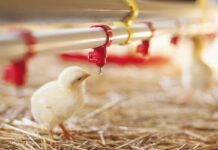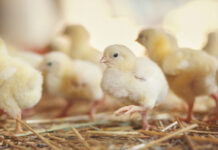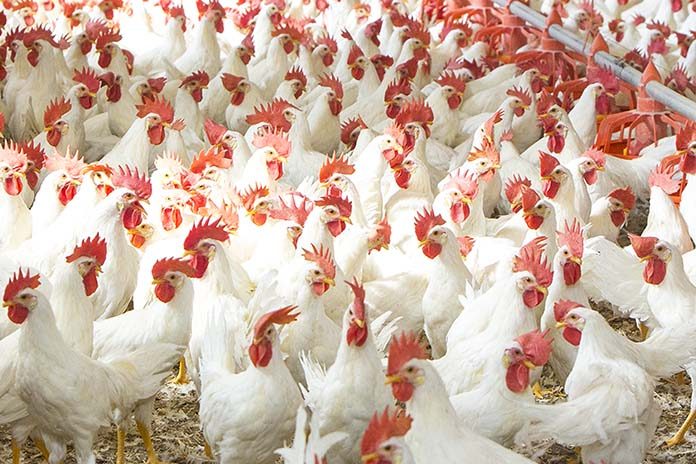
Part 2
The second part* in the series of two wich analyses the anthropological impact of the chicken from an archaeological/historical point of view: broilers had a role in economic development (indigenous and improved breeds in rural or pastoralist production, the change to industrial and larger scale peri-urban production is likely to be a major driver of meeting food requirements).
Changing patterns of human resource use and food consumption have profoundly impacted the Earth’s biosphere. Until now, no individual taxa have been suggested as distinct and characteristic new morphospecies representing this change. Here we show that the domestic broiler chicken is one such potential marker. Human-directed changes in breeding, diet and farming practices demonstrate at least a doubling in body size from the late medieval period to the present in domesticated chickens, and an up to fivefold increase in body mass since the mid-twentieth century.
Moreover, the skeletal morphology, pathology, bone geochemistry and genetics of modern broilers are demonstrably different to those of their ancestors. Physical and numerical changes to chickens in the second half of the twentieth century, i.e. during the putative Anthropocene Epoch, have been the most dramatic, with large increases in individual bird growth rate and population sizes. Broiler chickens, now unable to survive without human intervention, have a combined mass exceeding that of all other birds on Earth; this novel morphotype symbolizes the unprecedented human reconfiguration of the Earth’s biosphere.
-
Discussion
 The intensive production of broilers and rising rates of consumption (Figure 1) increases the standing biomass of domesticated chickens year on year. Over 65.8 billion meat-chicken carcasses were consumed globally in 2016 and this is set to continue rising. This may be an underestimate, given the standing population of 22.7 billion and lifespan of five to seven weeks. The FAO states that this number is aggregated from statistics that may be official, semi-official, estimates, or calculated data. The lifespan of broiler chickens is short (five to seven weeks) compared to egg-laying hens (1 year), both of which are slaughtered at a young age for economic reasons.
The intensive production of broilers and rising rates of consumption (Figure 1) increases the standing biomass of domesticated chickens year on year. Over 65.8 billion meat-chicken carcasses were consumed globally in 2016 and this is set to continue rising. This may be an underestimate, given the standing population of 22.7 billion and lifespan of five to seven weeks. The FAO states that this number is aggregated from statistics that may be official, semi-official, estimates, or calculated data. The lifespan of broiler chickens is short (five to seven weeks) compared to egg-laying hens (1 year), both of which are slaughtered at a young age for economic reasons.
The contrast between the lifespan of the ancestral red jungle fowl (3 years to 11 years in captivity) and that of broilers means that the potential rate of carcass accumulation of chickens is unprecedented in the natural world. Irrespective of the number of broiler chickens killed per annum, the standing population of 22.7 billion chickens is striking and mirrors other population data comparing domesticated with wild animal populations: for example, the biomass of domesticated cattle is 250 times higher than that of elephants. The standing biomass of domesticated poultry, mostly chickens, has been calculated as 5 Mt C, about three times higher than the total biomass of all wild bird species combined.
 The rise in the number of domesticated chickens over recent decades mirrors the decline in the population numbers of wild bird species, particularly those that are the most common. This mono-specific vast bird biomass is unprecedented in Earth’s recent history and perhaps also in Earth’s geological history. While fossil bird populations are difficult to estimate, it is thought that the most common wild bird in human history, the passenger pigeon, had a population of 3–5 billion in the 1800s.
The rise in the number of domesticated chickens over recent decades mirrors the decline in the population numbers of wild bird species, particularly those that are the most common. This mono-specific vast bird biomass is unprecedented in Earth’s recent history and perhaps also in Earth’s geological history. While fossil bird populations are difficult to estimate, it is thought that the most common wild bird in human history, the passenger pigeon, had a population of 3–5 billion in the 1800s.
The global range of modern broilers, in comparison with the geographically restricted range of their jungle fowl ancestors, is in part a factor of their climate-controlled (temperature, humidity and light) housing conditions. The vertical integration farming system of industrial production is reliant on the technosphere (the global emergent system that includes humans, technological artefacts, and associated social and technological networks).
Broiler farming is undertaken within a complex mechanized system that operates with the integration of computer software, electricity, transportation vehicles, refrigeration, feed processing factories and more. This is epitomized in the life cycle of intensively farmed broilers: eggs are laid in broiler breeder facilities and transported to hatcheries, where eggs are incubated artificially for 21 days. After hatching, the 1-day-old chicks are transported to high-capacity finishing units housing up to 50.000 individuals in climate-controlled sheds.
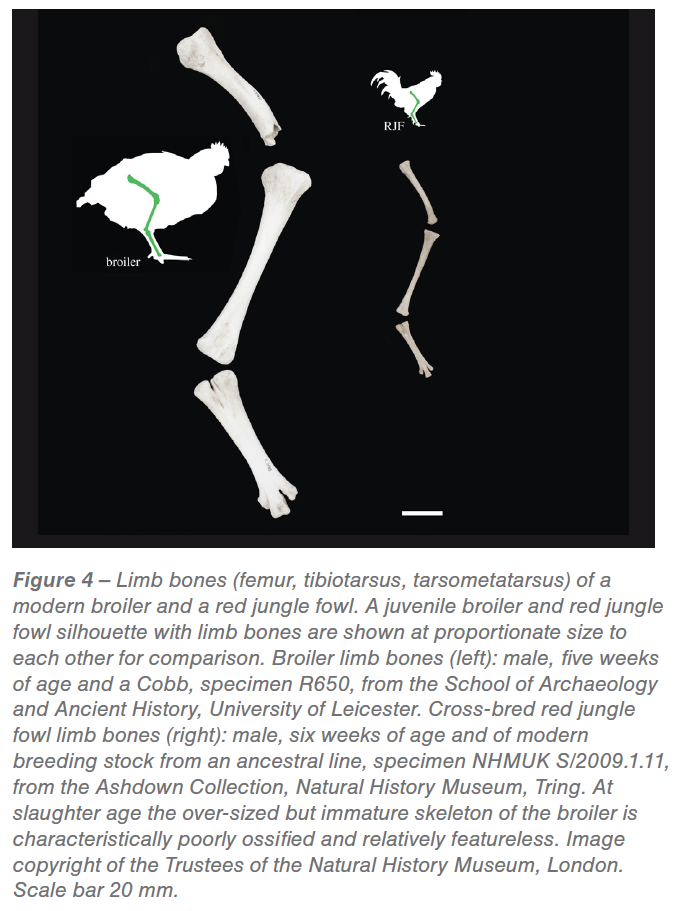 For the first week of life, chicks are kept at temperatures of 32 °C to 35 °C and relative humidity of 60% to 70%. At five to seven weeks old, broiler chickens are transported to the slaughterhouse, where most waste products (feathers, manure, blood etc.) are recycled via anaerobic digestion, incineration and rendering into edible by-products, all technology-dependent.
For the first week of life, chicks are kept at temperatures of 32 °C to 35 °C and relative humidity of 60% to 70%. At five to seven weeks old, broiler chickens are transported to the slaughterhouse, where most waste products (feathers, manure, blood etc.) are recycled via anaerobic digestion, incineration and rendering into edible by-products, all technology-dependent.
Breeding by natural selection has been modified by human-directed selection. While the size of the domesticated chicken in historical times was little different to the red jungle fowl (Figure 3), domestic chicken bone morphology shows that selective breeding practices took place as early as the sixteenth century. Chickens from the late twentieth century are markedly different in terms of size (Figures 3 and 4), growth rate (Figure 5) and body shape. The change in body mass and body shape has been visually documented by photographs of broiler breeds throughout ontogeny from 1957, 1978 and 2005.
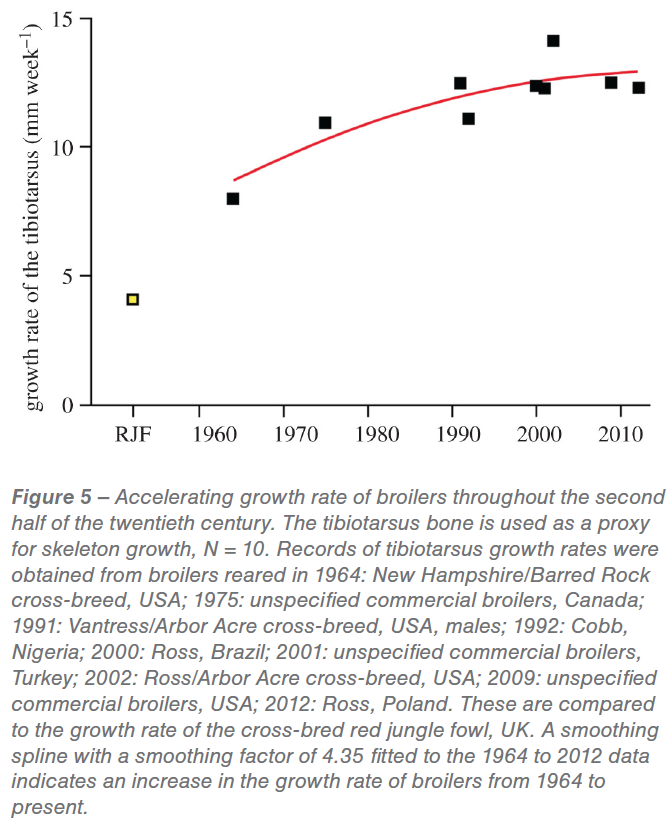 Broilers from a 1957 breed are between one-fourth and one-fifth of the body weight of broilers from a twenty-first century breed. The modern broiler is a distinctive new morphotype with a relatively wide body shape, a low centre of gravity and multiple osteo-pathologies. If left to live to maturity, broilers are unlikely to survive. In one study, increasing their slaughter age from five weeks to nine weeks resulted in a sevenfold increase in mortality rate: the rapid growth of leg and breast muscle tissue leads to a relative decrease in the size of other organs such as the heart and lungs, which restricts their function and thus longevity.
Broilers from a 1957 breed are between one-fourth and one-fifth of the body weight of broilers from a twenty-first century breed. The modern broiler is a distinctive new morphotype with a relatively wide body shape, a low centre of gravity and multiple osteo-pathologies. If left to live to maturity, broilers are unlikely to survive. In one study, increasing their slaughter age from five weeks to nine weeks resulted in a sevenfold increase in mortality rate: the rapid growth of leg and breast muscle tissue leads to a relative decrease in the size of other organs such as the heart and lungs, which restricts their function and thus longevity.
Changes in the centre of gravity of the body, reduced pelvic limb muscle mass and increased pectoral muscle mass cause poor locomotion and frequent lameness. Unlike most other neobiota, this new broiler morphotype is shaped by, and unable to live without, intensive human intervention.
Naturally omnivorous, the diet of the broiler chicken has become more grain-based with approximately 60% of broiler feed composed of cereals such as maize, wheat and barley. Diets vary globally, with maize most commonly used in the USA because it has a higher nutrient value than other cereals. Additions to the dietary cereals can include fishmeal and re-processed hatchery and broiler waste (egg shells, chicks and chickens).
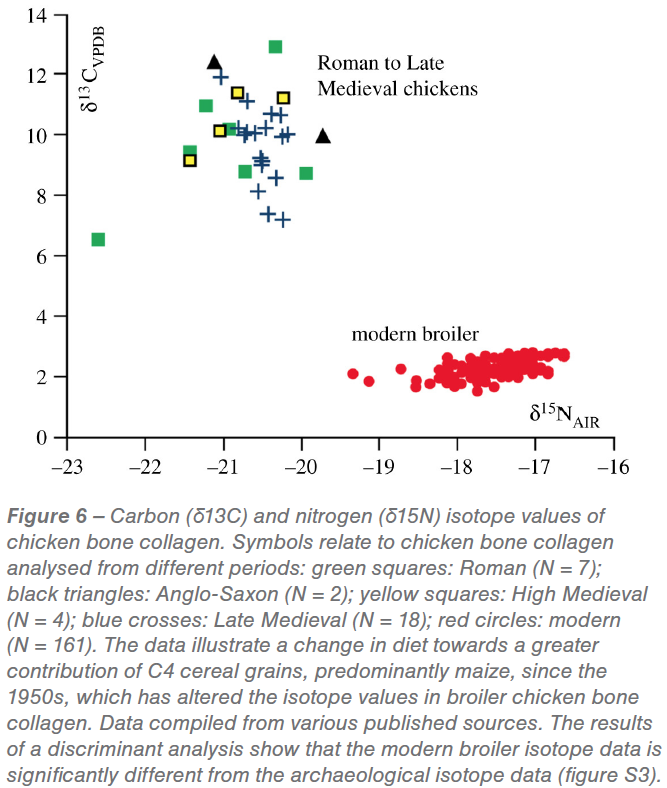 The alteration to chicken diets is designed to reduce the amount of feed used while increasing meat yields; however, it also homogenizes nutritional intake, eliminating a source of natural variation within the stock (Figure 6). The current plateau in broiler growth rates may not be maintained, with current research focusing on new technologies to increase the protein intake of broiler diets by using insect meal instead of plant proteins.
The alteration to chicken diets is designed to reduce the amount of feed used while increasing meat yields; however, it also homogenizes nutritional intake, eliminating a source of natural variation within the stock (Figure 6). The current plateau in broiler growth rates may not be maintained, with current research focusing on new technologies to increase the protein intake of broiler diets by using insect meal instead of plant proteins.
The genetic make-up of the modern broiler morphospecies is equally striking. The domestic chicken’s genetic make-up differs from the ancestral red jungle fowl, in terms of deletions and mutations, some of which relate to the modification of the animal for maximum growth. For example, the thyroid stimulating hormone receptor (TSHR) allele has a pivotal role in metabolic regulation and photoperiod control of reproduction, allowing domestic breeds to reproduce year-round.
This genetic marker could be used to recognize Gallus gallus domesticus in the future fossil record, in the way that the β-carotene dioxygenase 2 gene associated with yellow skin colour resulting from a diet of maize may be identified in archaeological chicken bones from approximately 500 years ago. Three companies worldwide supply 90% of broiler chicks and selective breeding has resulted in 50% or more of genetic diversity loss in commercial lines compared with ancestral breeds.
Global human trends towards increased animal protein consumption, along with an increased human population, is impacting on land use and wild species populations. Chickens have the greatest feed efficiency of any farmed animal species, but their numerical dominance is reflected in feed consumption. In the USA the combined feed consumption by broiler and egg-laying chickens has been calculated as 58 Mt (×109 kg) of dry concentrates (grains and by-products) per year; the greatest feed volume of any farmed animal group.
Overall, the land area required to produce feed for chickens is lower than for pigs and cattle, who consume processed roughage and pasture, which increases the overall land-use burden. Nevertheless, the land area and reactive nitrogen emitted (from fertilizers) from the production of chicken feed is significantly higher (more than double) that used to grow plant crop staples (rice, wheat and potatoes). The total global energy consumption (electricity, natural gas) used in the broiler production system in Europe is estimated to be higher than that for the production of beef or pork, although a global data analysis is yet to be undertaken.
What is the potential for broilers to become fossilized? Bird carcasses in the wild are scavenger- and decay-prone and so do not commonly fossilize. Chicken bones, by contrast, are often sold intact within products for human consumption, such as chicken wings, drumsticks and whole birds, and post-consumption the discarded bones form a common component of ordinary landfill sites as part of domestic garbage. The low skeletal density of chicken bones would normally mitigate against long-term preservation potential.
However, organic materials are often well preserved within landfill deposits, where anaerobic conditions mean that bones ‘do not so much degrade as mummify’. The osteo-pathology of modern broiler bones could be used as an additional stratigraphic characteristic of late-twentieth century birds which have been bred for weight gain and/or a fast growth-rate. Further research is needed to document the extent of the occurrence and type of osteo-pathologies in broilers in the twentieth century in order to better constrain their incidence through this time interval.
Carcasses can be disposed of in on-farm burial pits from routine losses during production, or as mass-burials at landfills resulting from the depopulation of flocks affected by pathogenic outbreaks of avian influenza, as when 10 million poultry were euthanized in South Korea in 2008. The broiler chicken is therefore likely to leave a widespread and distinctive biostratigraphic signal in the sedimentary record, as a key fossil index taxon of the Anthropocene. Its potential in this respect is similar to that of other anthropogenic materials which have appeared, or exponentially accumulated in volume.
These include during the Great Acceleration from the mid-twentieth century, materials such as plastic, concrete and spheroidal carbonaceous particles. Broilers are globally distributed and their carcasses have accumulated in settings which lead to good fossil preservation potential. Chicken bones, though not as homogeneously distributed as some geochemical anthropogenic markers such as radionuclides, will be abundant at landfill sites and other widely distributed accumulations. Given this global distribution, together with its huge population size and distinctive biology, genetics and bone geochemistry, the broiler chicken may be viewed as a key species indicator of the proposed Anthropocene Epoch.
-
Conclusion
The advent of the fast-growing broiler morphotype in the 1950s and its uptake across industrial farms worldwide, can be viewed as a near-synchronous global signal of change to the biosphere, currently maintained by humans and the technosphere. Modern broiler chickens are morphologically, genetically and isotopically distinct from domestic chickens prior to the mid-twentieth century. The global range of modern broilers and biomass dominance over all other bird species is a product of human intervention. As such, broiler chickens vividly symbolize the transformation of the biosphere to fit evolving human consumption patterns, and show clear potential to be a biostratigraphic marker species of the Anthropocene.
End of the second part
Read first part
References are available on request
Electronic supplementary material is available online at https://dx.doi.org/10.6084/m9.figshare.c.4305458.
© 2018 The Authors. Published by the Royal Society under the terms of the Creative Commons Attribution License http://creativecommons.org/licenses/by/4.0/, which permits unrestricted use, provided the original author and source are credited.



